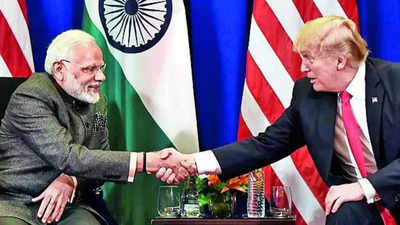
BENGALURU: As has been the case with any US Presidential election in the past few decades, the 47th also has stakes transcending national boundaries with both allies and rivals hedging future bets — anticipation, speculation, wishful thinking all rent the air.
And as Donald Trump prepares to occupy the Oval Office for the second time, Indian science and technology sector anticipates bilateral partnership to remain robust, even as there’s speculation that leadership change may, albeit slightly, alter the trajectory of this cooperation.
Trump takes office as India and the US are significantly expanding their technological cooperation across multiple critical and emerging sectors, with particular emphasis on space exploration, quantum computing, artificial intelligence, and advanced telecommunications.
For instance, Isro and Nasa have strengthened their space partnership, signing a joint statement in Jan 2024 to enhance collaboration, including International Space Station initiatives. Their key joint project remains the Nisar satellite for Earth observation. Indian astronaut-designates Shubhanshu Shukla and Prashanth Nair are training in the US — the former will go to ISS on an Axiom Space mission.
The Initiative on Critical and Emerging Technologies (iCET), launched in Jan 2023, has facilitated broader tech cooperation. The second iCET Summit in July 2024 reviewed progress in space, semiconductors, AI, quantum computing, and clean energy.
The US National Science Foundation and Indian scientific departments have expanded research partnerships across multiple fields. The Sept 2023 MoU between the IIT Council and Association of American Universities established the India-US Global Challenges Institute, focusing on sustainable energy, health, semiconductors, AI, and quantum science.
Principal Scientific Advisor to GoI, Prof AK Sood, told TOI: “I don’t see any major red flag or reason to expect drastic changes in S&T cooperation. These are long-standing, national priorities for both countries, and commitment to enhance technological cooperation will likely continue. The large, ongoing projects will proceed without significant disruption.”
Terming Indo-US S&T cooperation “very mature” and “well-established”, particularly in emerging and critical technologies, former DST secretary Prof Ashutosh Sharma said there is a consensus direction that this cooperation is headed.
“…Areas like quantum technologies, AI, biotech, and clean energy would likely remain on track regardless of the political change. Basic and translational research cooperation is well-established at this point,” he said.
Nisha Mendiratta, executive director, Indo-US Science & Technology Forum (IUSSTF), said that by and large, the long-term collaborations and cooperations will continue. “There may be some shifts in priorities, but the fundamental cooperation in providing technological solutions to societal challenges is expected to remain a key focus area,” she added.
Space is geopolitics, says Susmita Mohanty, director general of space think tank Spaceport SARABHAI, adding that in this geopolitical play that began in the 1960s, France (CNES) and Soviet Union/Russia (Roscosmos) have been India’s friends for over half a century.
“The US will need several decades to catch-up to that level of cooperation and to heal the negative impact of their 1998 technology sanctions on India. Notwithstanding who the US President is, the 21st century cooperation between Isro and Nasa (e.g. Moon, Mars missions, Nisar) will stay the course. The US needs India for economic and strategic reasons, so there is no going back. However, ITAR and other regulatory hurdles will continue to limit the scope, scale and speed of the Indo-American alignment,” Mohanty said.
She added that if the US was indeed serious about building trust and a long-term relationship with India in aerospace and defence, the US President should consider elevating India to the status of an “ally”.





